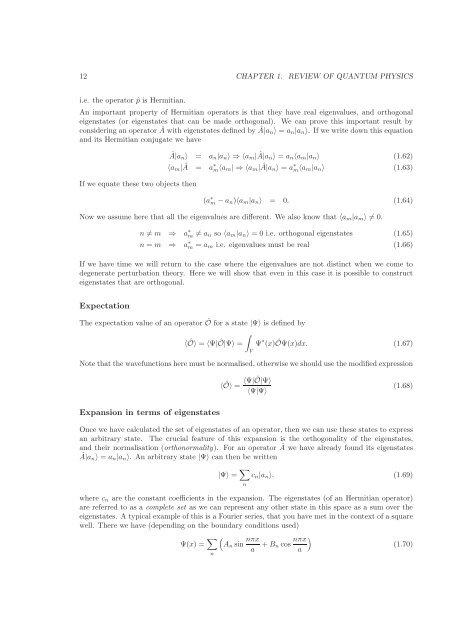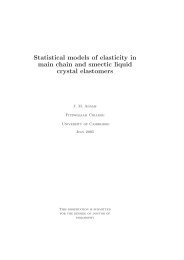Review of Quantum Physics
Review of Quantum Physics
Review of Quantum Physics
You also want an ePaper? Increase the reach of your titles
YUMPU automatically turns print PDFs into web optimized ePapers that Google loves.
12 CHAPTER 1. REVIEW OF QUANTUM PHYSICSi.e. the operator ˆp is Hermitian.An important property <strong>of</strong> Hermitian operators is that they have real eigenvalues, and orthogonaleigenstates (or eigenstates that can be made orthogonal). We can prove this important result byconsidering an operator  with eigenstates defined by Â|a n〉 = a n |a n 〉. If we write down this equationand its Hermitian conjugate we haveIf we equate these two objects thenÂ|a n 〉 = a n |a n 〉 ⇒ 〈a m |Â|a n〉 = a n 〈a m |a n 〉 (1.62)〈a m | = a∗ m〈a m | ⇒ 〈a m |Â|a n〉 = a ∗ m〈a m |a n 〉 (1.63)(a ∗ m −a n )〈a m |a n 〉 = 0. (1.64)Now we assume here that all the eigenvalues are different. We also know that 〈a m |a m 〉 ̸= 0.n ≠ m ⇒ a ∗ m ≠ a n so 〈a m |a n 〉 = 0 i.e. orthogonal eigenstates (1.65)n = m ⇒ a ∗ m = a m i.e. eigenvalues must be real (1.66)If we have time we will return to the case where the eigenvalues are not distinct when we come todegenerate perturbation theory. Here we will show that even in this case it is possible to constructeigenstates that are orthogonal.ExpectationThe expectation value <strong>of</strong> an operator Ô for a state |Ψ〉 is defined by∫〈Ô〉 = 〈Ψ|Ô|Ψ〉 = ∗Ψ (x)ÔΨ(x)dx. (1.67)Note that the wavefunctionshere mustbe normalised, otherwisewe shoulduse the modified expressionV〈Ψ|Ô|Ψ〉〈Ô〉 =〈Ψ|Ψ〉(1.68)Expansion in terms <strong>of</strong> eigenstatesOnce we have calculated the set <strong>of</strong> eigenstates <strong>of</strong> an operator, then we can use these states to expressan arbitrary state. The crucial feature <strong>of</strong> this expansion is the orthogonality <strong>of</strong> the eigenstates,and their normalisation (orthonormality). For an operator  we have already found its eigenstatesÂ|a n 〉 = a n |a n 〉. An arbitrary state |Ψ〉 can then be written|Ψ〉 = ∑ nc n |a n 〉, (1.69)where c n are the constant coefficients in the expansion. The eigenstates (<strong>of</strong> an Hermitian operator)are referred to as a complete set as we can represent any other state in this space as a sum over theeigenstates. A typical example <strong>of</strong> this is a Fourier series, that you have met in the context <strong>of</strong> a squarewell. There we have (depending on the boundary conditions used)Ψ(x) = ∑ (A n sin nπxa +B ncos nπx )(1.70)an
















